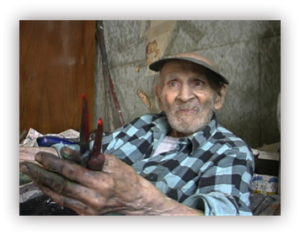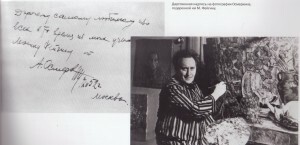Walk through the long halls of the New Tretyakov Gallery, past all the famous masterpieces of the beginning of the 20th Century, and you are reminded of a bygone age, just before the 1917 Revolution when the arts scene was exploding with new liberal possibilities and new dynamic movements; the World of Art, Sergei Diaghilev, the Ballets Russes with their fantastic décors and costumes by the new leading artists of the Avant-Garde, and then the colorful "Jack of Diamonds" group with its Russian folk undertones. This was before the "rot" of Socialist Realism set in and artists were forced to conform to the Socialist movement - under the threat of lost work, reputation or even their very lives. A bygone age whose main protagonists have long since disappeared from the art world. Or have they?
One of the patriarchs of Russia's Avant-garde movement, Moisei Feigin, is still around to tell his tale. He may not be as well known as some of the great names of the early 20th century, but at 103 years old is the only remaining member of the "Jack of Diamonds" artistic group founded in Moscow in 1909. He is still lives here and was last week entered the Guinness Book of Records as the "oldest working professional artist."
His large painter's hands, covered with paint, can still work, and although his back is now bent with age, his wizened face with its impish smile and sparkling eyes is full of life and humor. Although generally in good health, Feigin, ironically enough, was unavailable for an interview because he was tending to his sick daughter. His old friend Sasha, who prefers not to be called by his real name, answered our questions.

Born in November 1904, Feigin's incredible life spans all the upheaval of early 20th Century Russian History, from the Tsarist rule to the Bolshevik Revolution to the Stalin repressions and subsequent Thaw. He was born in Warsaw and moved to Moscow with his family when he was ten. In 1921, he began his studies at the Higher Art and Technical Studios in Moscow (VKhUTEMAS).
"Here he studied under Alexander Osmyorkin, Ilya Mashkov and Aristarkh Lentulov," says Sasha. "The Jack of Diamonds was formed in the 1910s and continued right up to the 1930s. This association, with its powerful optimism, its exaggerated emotionality and bright expressive colors and Russian folk motifs, stood in contrast with the earlier more geometric and abstract works of the early avant-garde and included artists such as Falk, Lentulov, Mashkov, Kuprin and Konchalovsky. They looked mainly to Cezanne, but also Picasso, Gauguin and Matisse for their main inspiration and a number of them were even referred to as the Moscow Cezannists.
"In 1931, art succumbed to a heavy censure program run by the Soviet regime, which brought about the mass capitulation of talent and budding avant-gardist ideas. Stalin issued a decree forbidding all Formalist art, leaving room only for Socialist Realism. "It was just like in Germany, where Hitler called this art degenerate. Formalist paintings by painters such as Kandinsky were burnt and destroyed," says Feigin's friend Sasha. Works by Malevich, Kandinsky and Popova were all taken out of museums and the canvasses given to other painters to paint Socialist Realism over them.
"From 1931 onwards, Feigin too had to surrender to Soviet Realism, working on portraits of Stalin and Lenin in order to earn his living. When Feigin's teacher, Alexander Osmyorkin, was condemned for daring to claim that Cezanne was a great artist, Feigin was the only one to show support for him and greet him at a gathering of the Union of Artists where all were even afraid to be seen with him for fear of being arrested. Despite taking this risk, he escaped arrest and continued to work, although he lost his previous prestige and popularity. Moral compromise was a fact of life in those days. Feigin himself doesn't blame anyone for not standing up for him and for others. "There was just to much to lose for everyone then, too much was at risk. Life was terrifying for all." And yet suffering, according to Feigin, is what makes an artist. Clearly the fear and suffering he endured have not affected his lifespan."
He has been called a genius, and yet Feigin's name has not become a household name, such as Malevich, Kandinsky or Cezanne. One reason was that after Osmyorkin's persecution and the reputation of all his students, including Feigin, was subsequently tarnished, they became victims of what Feigin has called the "spoilt generation." He did, however, manage to live on his art during his Socialist Realism phase, whereas Osmyorkin was shunned in every art institution and was no longer allowed to teach in Moscow, St. Petersburg or Yerevan, where he had previously been held in such great esteem.

In Feigin's words, the political portraits were his way of making "money on the side" while his real art came out at home or in the woods. He was even commissioned with two other artists to paint a four-story head of Stalin for the residential home on the Kotelnicheskaya Embankment, in one of the Seven Sisters. "As soon as Khrushchev came to power with the advent of the 1960s Thaw," says Sasha, "he immediately went back to his previous style of painting."
And yet even in his Socialist Realist art Feigin's talent and wonderful use of color shine through. One example is a painting of his daughter in the 1940s when she was a little girl. Despite the style imposed on the artist, the painting is beautifully composed and harmonious in its content and choices of vibrant color.
"He really is a brilliant painter," says Sasha. "Everything, form, volume, color, movement. All this is present in his work. And the unusual thing is that his work just gets better and better the older he gets. So many artists now are so commercialized. Not so Feigin, for whom money has never meant anything." Currently the artist lives with his daughter and is more or less confined to his flat
"He doesn't go out any more and he uses walking sticks to get around. He has a steady hand, however, and his memory is unbelievable. He remembers how, as a three-year-old child, on a visit to his aunt's he started drawing a little person on the wall with a rusty old nail. At the time he was told off, but it's on that day that his passion for drawing began."
Unfortunately very few of Feigin's earlier works survived the war. Any of the remaining works are mainly from the 1950s and 60s. "Feigin is becoming more and more popular and his popularity is growing. There is actually very little real art left, so he is now very sought after. It's unlikely one would find his paintings in any auction nowadays, since everyone wants to hang on to his works. They realize what masterpieces they really are."
Currently, Feigin's art is located in various museums in Russia, including the State Russian Museum in St. Petersburg, the Tretyakov Gallery, the Moscow Museum of Modern Art as well as private collections and museums in Great Britain, Germany, Israel, Sweden, Switzerland and the U.S. One of his paintings has pride of place at the villa of British designer Sir Paul Smith among paintings by Matisse and Picasso.
Feigin's last exhibition was held at the Central House of artists in Moscow in April-May 2007.
A large exhibition of his works is planned for the near future, although the time and place are yet to be confirmed, as is his place in history.
We can only hope that he will remain alive long enough to witness the long overdue and well deserved fruits of fame and recognition.

